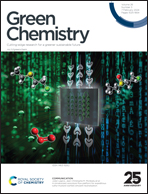Highly chemoselective and fast practical visible photoreduction of nitroaromatic compounds to aromatic amines and amides using a self-assembled triad TiO2-TEOA-NC (LMCT/EDA) complex system†
Abstract
In this study, a TiO2-P25 photocatalyst was chemically complexed with a triethanolamine (TEOA) molecule using visible light irradiation and its photocatalytic activity was evaluated in the photoreduction of a wide range of nitroaromatic compounds. The chemically adsorbed TiO2-TEOA complexes were characterized by Fourier-transform infrared spectroscopy, thermogravimetric analysis, UV–vis diffuse reflectance spectroscopy, photoluminescence spectroscopy, N2 adsorption/desorption isotherm analysis and dynamic light scattering (DLS) analysis. The TEOA-functionalized TiO2-P25 surface complex shows enhanced photocatalytic activity under visible light irradiation (λ = 400 nm) when compared to pure TiO2-P25. This enhancement results from the charge transfer (CT) complex formation between TiO2 and TEOA, as well as electron transfer via a ligand-to-metal charge transfer (LMCT) mechanism. Interestingly, in the presence of a nitro compound (NC), the chemically absorbed TiO2-TEOA forms a TiO2-TEOA-NC triad complex system. The three components spontaneously self-assemble into a heterosupramolecular system that performs electron transfer as a single function. As a result, after absorbing visible light, the triad system demonstrates unique photocatalytic performance as compared to both TiO2-TEOA and TEOA-nitro complexes. The increased charge separation in the triad system was demonstrated by photocurrent and electrochemical impedance spectroscopy (EIS) under visible light irradiation. Electrochemical techniques, including photocurrent, impedance, light absorption and emission spectroscopies, demonstrated that increasing the current and charge separation within the triad system effectively inhibits the recombination of electron-hole pairs. The results of the study indicate that the conversion of nitroarenes to their corresponding amines can take place rapidly and on a large scale, yielding excellent results even under atmospheric pressure and air. It is noteworthy that this is the first study in this area, which highlights the potential of reducing nitroarenes into their corresponding amines with a high efficiency of up to 5 mmol using a photocatalytic procedure. The chemoselectivity of this system was excellent, even in the presence of other reducible groups in the nitro compound. Additionally, a one-pot reductive conversion of nitroarenes to amides was carried out with high efficiency using triethyl orthoformate, acetic anhydride, and benzoic anhydride.



 Please wait while we load your content...
Please wait while we load your content...